Rules
This page has all the rules you need to play Cross Universe.Note that the last two sections are more in-depth, going over some of the technicalities of the rules.
You most likely don't need to fully understand them to just play the game casually.
If you ever have any questions about the rules, you can always ask on the community discord server:
The Rules
・ Game Objective:
In this game, two people play as sorcerers, fighting one another alongside their chosen companion, known as their “partner”.
You can use cards to summon units, cast spells and deploy items.
The aim is to attack the enemy partner with your units until you deal enough damage to achieve victory.
・ The Cards that Form your Power:
There are three main kinds of cards: Units, spells and items.
Unit cards allow you to place down a character who will attack and defend.
Spell cards can be played regardless of whose turn it is.
Item cards are played during your turn.
Basic rules
Deck Construction:
Choose 30 to 50 cards to make a deck.
You can only choose the same named card a maximum of three times.
Life:
At the beginning of the game you have 1000 life.
Life is reduced through fights and card effects.
If your life reaches 0, you lose.
Hand:
Each player holds cards in their hand.
When a game starts, both players draw 5 cards from their deck to their hand.
There's no limit to how many cards can be in your hand, but at the end of the mana supply phase, if you have more than 8 cards in your hand, you must discard down to 8 cards.
Mana:
This game uses a concept called 'mana'.
In the mana supply phase, the player whose turn it is receives mana, which is required to play most cards.
Both players start the game with 0 mana.
There's no upper limit to how much mana you can have but if a player has more than 5 mana during the mana supply phase, it'll be reduced down to 5.
Partners:
At the beginning of the game choose one unit from your deck as your partner.
That unit will always remain on the field and can attack or use its effects.
However, mana equivalent to its level is required to maintain it.
In the mana supply phase, if you can't pay the required mana as upkeep, you lose.
By default, the partner cannot leave the field.
The partner cannot be destroyed in battle and card effects etc. that would cause it to leave the field aren't processed. (The only exception to this is that it can be exchanged for another unit.)
Placement of Cards:
The locations where cards are placed are called zones.
There are 5 sections in the 'unit zone' and 4 in the 'spell & item zone'.
Additionally, there's a 'partner zone', 'exile zone', the deck and the discard pile.
The unit zone, spell & item zone and partner zone are called the 'field'.
Card Types
All cards have these things in common:
1. Card Name
2. Level
The mana cost to play a card. For a partner, this is the upkeep cost.
3. Types
Written in the middle of the card, these are keywords with no inherent meaning. They are only referred to by card effects.
4. Effects
The body of text on a card. Some of the abilities are instantaneous, some are activatable, and some occur constantly.
Unit cards also have an Attack and Defense.
These are two numbers that indicate strength.
Attack is the number referenced when attacking.
Defense is the number that allows units to survive attacks.
Spell cards are additionally divided into these categories:
-Standard Spells
These spells are moved to your discard pile immediately after resolving their effect.
-Enchant Spells
When casting, choose a unit. After that this spell will remain on the field with a static effect. If the enchant conditions cease to be met or the enchanted unit leaves the field, the enchant spell is destroyed.
-Continuous Spells
These spells remain on the field with a static effect.
Sometimes you need to activate their effects.
Other times, simply existing causes the effects to be active.
Item cards, much like spells, are divided into similar categories:
-Standard Items
These items are moved to your discard pile immediately after resolving their effect.
-Equipable Items
When deploying, choose a unit. After that this item will remain on the field with a static effect.
If the equip conditions cease to be met or the equipped unit leaves the field, the equipable item is destroyed.
-Continuous Items
These items remain on the field with a static effect.
Sometimes you need to activate their effects.
Other times, simply existing causes the effects to be active.
Abilities
The abilities of units, equipable/continuous items and enchant/continuous spells are divided into the following types:
・ Optional Abilities
These abilities are held by units, equipable items and continuous items.
They can be identified by phrases like "You may..., to activate this.", or "Once during your turn (in the main phase) you may activate this.".
Unless otherwise specified, you can activate optional abilities only during your turn's main phase and only if the card is on the field.
・ Trigger Abilities
These abilities are generally indicated by phrases such as "After ..., you may activate this.", "During each end phase, activate this.", etc.
They can (or must) be activated only when the given condition is met.
They can only be activated if the card is on the field. (except if the condition itself causes the card to move. ("After this card is destroyed ..."))
If the ability says "you may", it is optional, otherwise it must be activated when the condition is met.
If a phase is specified ("During your end phase, activate this."), the ability can only be activated once per turn.
・ Static Abilities
Static abilities are active as long as the card is in a designated area without being activated.
Unless otherwise specified, these abilities are active when the card is on the field.
Some of these abilities just continue to apply while others only apply when a condition is met.
・ Fast Abilities
Fast Abilities on spells can be identified by phrases like "You may ..., to activate this." or "Once during each turn, you may activate this.".
On units and items, these say things like "During each player's turn ...".
Similar to casting spells, these can be activated at any time, even if it is not your turn.
Though, unless otherwise specified the card must be on the field for you to be able to activate these.
Game Flow
1. Choose a partner
Both players choose one unit from their decks as their partner. Don't reveal it to your opponent yet.
2. Decide who will go first
Randomly decide the first player and the second player.
3. Prepare starting hands
Draw 5 cards from your deck to your hand.
4. Begin the game
Both players reveal their partner and continue the game as follows.
・ First Player's Turn
- Mana Supply Phase
First, if any player has more than 5 mana, their mana will be reduced to five.
Next, the active player gains 5 mana.
Then they pay their partner's level in mana. If they can't pay, they loose the game.
If they still have more than 5 mana, it will again be reduced to 5.
At the end of the mana supply phase, any player with more than 8 hand cards discards down to 8.
Note: You can't play any cards or use abilities during this phase.
- Draw Phase
First, the active player draws a card.
Though, on the very first turn of the game, you do not draw a card here.
- Main Phase 1
During this phase, you can do most actions, like summoning units or deploying items.
At the end of the phase, the active player chooses whether to enter the battle phase or skip to the end phase.
- Battle Phase
(The battle phase can't be entered on the very first turn of the game)
During this phase, the active player can declare their units to attack.
The active player repeats the steps below as long as they can and want to.
Declare Attackers:
Select a unit to attack, then select the attack target.
Fight:
The result of the fight is determined.
If before the fight occurs the unit declared to attack or the attack target were removed from the field, skip the fight.
- Main Phase 2
This phase occurs after the battle phase.
The active player can do the same things as they could in main phase 1.
If there was no battle phase, this phase does not occur.
- End Phase
The turn ends.
・ Second Player's Turn
The same as the first player's turn.
・ How Fights Work
1. Compare the attacker's Attack to the target's Defense.
If the Attack is greater the attacker destroys the target. If the unit got destroyed successfully, skip to step 3.
2. If the unit wasn't destoyed, a 'counterattack' occurs.
Compare the target's Attack to the attacker's Defense. If it is greater, the attacker will be destroyed.
(This does not count as an attack, it is just part of how a single fight/attack works.)
3. Discard the destroyed unit.
Notes:
Spells can't be cast and effects can't be activated during a fight.
However, some abilities don't require activation and can happen during a fight. (Such as 'If the equipped unit is to be destroyed, destroy this card instead.')
In a fight involving a partner, if the Attack exceeds the partner's Defense, the difference will be dealt as damage to the player directly.
The partner won't be destroyed by this.
・ Victory Conditions
There is three main victory conditions:
1. Your opponent's life becomes 0.
2. Your opponent tries to draw but doesn't have enough cards in their deck.
3. Your opponent lacks the mana to pay their partner's upkeep cost.
If both players meet victory conditions at exactly the same time, the game ends in a draw.
Basic Actions
・ Draw
A draw is the act of adding the top card of your deck to your hand.
Each player draws a card in the draw phase of their turn.
When you are to draw but have no cards in your deck, you lose the game.
・ Summon
Summoning refers to the act of placing a unit card in the unit zone and paying its level in mana.
Each player can summon one unit during the main phase of their turn. (Their 'standard summon')
In addition to that, players can summon units by the effects of cards. But you still need to pay the mana cost when doing so.
・ Cast
Casting refers to the act of placing a spell card in the spell & item zone and paying its level in mana.
Spell cards can be played at almost any time, during either player's turn.
・ Deploy
Deploying refers to the act of placing an item card in the spell & item zone and paying its level in mana.
Each player can deploy items during the main phase of their turn.
・ Activate
You can activate abilities of your spells, items or units that already exist on the field.
By default, units and items can be activated only during your main phase while spells can be activated at almost any time.
By default, activating an ability does not cost any mana.
・ Attack
Every unit on the field has one right to attack per turn and you can declare all of them to attack your opponent's units during your battle phase.
When attacking, you may only select the opponent's partner as the target if there are no other units on their field.
・ Combined Attack
When declaring your partner to attack, you may declare additional units to attack as well to perform a combined attack.
To take part in a combined attack, a unit must share a type with the partner and must still have a right to attack.
During the fight, the attack power will be the Attack of all attacking units combined.
Participating units are treated as being in a fight and as attacking and will lose their right to attack.
Units that need to meet conditions in order to attack are also required to meet those conditions to participate in a combined attack.
If a counterattack occurs, it is against the partner alone.
・ Retire
Retiring allows you to gain mana by discarding your own units.
You can only retire once per turn, during your main phase.
To retire, first select any number of units on your field and declare a retire.
After that, discard all of them and gain their combined level in mana.
Note that you cannot retire units that have been summoned this turn or the turn before.
Glossary
・ Counterattack
If during a fight the attack target is not destroyed, a counterattack occurs.
The target's Attack and the attacker's Defense are compared. If the Attack is greater, then the attacker is destroyed.
This is not treated as an actual attack and is just a part of how attacks are evaluated.
・ Destroy
Cards are destroyed in fights and by card effects.
Destroyed cards are discarded.
・ Discard
This may be a cost of using a card, caused by destruction or a card effect, etc.
Discarded cards are put in their owner's discard pile.
・ Exile
This may be a cost of using a card, caused by a card effect, etc.
Exiled cards are put in the exile zones.
As long as a card remains in the exile zone, other cards generally won't interfere with it.
・ Place, Return to the Field, Put back
"Place" or "Return to the field" are the acts of placing a card on the field, often by the effect of another card.
This is not treated as a summon, cast or deploy and doesn't cost anything.
When a card is being returned to the field, it is returned to the player's field it was most recently on.
・ Equip, Enchant
This is the effect of assigning an equipable item or an enchant spell to a target.
It may be the result of casting or deploying but can also be caused by card effects.
Equipping or enchanting itself has no cost.
・ Exchange
The act of two cards swapping places.
It is not treated as a summon, cast or deploy and has no cost.
・ Use
Refers to interacting with a card in a way other than using it as a cost, such as summoning, casting, deploying or activating.
・ Cost
Cost expresses the requirements to perform some actions, such as "Do X to cast this." or "Whenever this card is declared to attack, do X".
This also includes the mana cost paid when summoning, casting or deploying a card.
The requirements for things that happen when applying a static abilitiy like "When X is to happen, do Y instead." also count as a cost.
The cost of an action must be played before performing the action and creating its block.
If you can't pay it, you cannot perform the action.
・ Add ... to your hand
This refers to moving cards to your hand from decks, discard piles etc. to your hand.
When the card comes from a location that is not visible to the opponent, through means other than drawing it, it must be shown to the opponent.
・ Cancel
The act of preventing an attack, summon, casting, deployment, activation or the effects of static abilities from occurring.
In case of actions that create blocks being cancelled, their block will end without being executed.
When cancelling the summoning, casting or deploying of a card, the card will be discarded without being put on the field and the block will end.
Actions that have been cancelled are still treated as though they have been attempted and can't be repeated if they can only be done once.
・ Shuffle
The act of randomizing the order of your deck.
The deck is always shuffled at the start of the game, after selecting your partner.
The deck is also shuffled every time you need to inspect its contents or return a card to the deck.
The only exception to that is when a location in the deck is explicitly specified, such as a card being put on the top or bottom of the deck.
・ Tokens
A token is a unit that is created by the effect of a card.
If tokens are discarded, exiled or added to a deck or hand, they will be removed from the game instead of going there.
Tokens are not strictly cards but are placed in the unit zone just like regular units.
Since they are treated like units, you need to pay their level in mana when summoning them.
It is also possible to retire tokens and discard or exile them as the cost of an action.
Tokens can also become partners due to the effects of cards such as 'Buddy Change'
When placing tokens on the field, it can be convenient to use coins to represent them.
・ Counters
Counters are markers placed on cards by card effects.
They are referred to by the effects of various cards.
Counters are only placed on cards on the field and are removed when the card moves off the field.
Each counter has a unique name and only functions as that type of counter.
They themselves have no inherent effect.
・ This Card
"This card" always refers to the card on which the currently processing effect exists.
Stacks and Blocks
In this game, there is the concept of 'stacks' and 'blocks' which dictate how almost all effects are resolved.
A stack represents the timing of actions while blocks on those stacks represent the individual actions.
The only execption to this is the fact that the mana supply phase does not have this concept.
The following actions cause blocks to be created:
- The standard draw of the draw phase
- The standard summon
- Casting spells
- Deploying items
- Activating card effects
- Retiring units
- Declaring attacks
- Fight resolutions
In addition, actions that create blocks are divided into 'normal actions' and 'quick actions'.
Normal actions can be done only on your turn while quick actions can be done regardless of whose turn it is.
Quick actions include casting spells, activating trigger abilities and activating fast abilities.
Everything else is a normal action.
Processing of Blocks:
At the start of every phase, Stack 1 is created.
Whenever a stack is created, the active player has the right to create a block.
The other player only has the right to create a block if the active player relinquishes that right.
The first block on a stack is called 'block 1'.
Once block 1 has been created, the other player gets the right to create block 2.
A player can only create two blocks in a row if their opponent relinquishes the right to create another block in between.
If both players relinquish their right to create a block in a row, the stack is complete and will be executed in reverse order.
After that, another stack (stack 2) will be created and handled the same way as stack 1.
If both players relinquish their right to create a block as the first block of stack X, the chain of stacks will end and a new stack 1 will be created.
If both players relinquish their right to create a block as the first block of stack 1, the current phase will end.
Normal actions can only be done during your own turn, on block 1 of stack 1, everything after that needs to be a quick action.
The standard draw and fight resolutions are mandatory and are forced to be created as the first block of a stack 1 if they are possible.
Quick actions that specify "After" can only be activated on the stack one after the stack where their condition happened.
So if a card says "After a unit is destroyed, you may activate this." and a unit is destroyed on stack 1, that ability can be activated at any point during stack 2.
In case of mandatory trigger abilities, these must be activated as soon as possible during this stack.
If timing of an action implies it to happen during another block, it is referring to the stack that the block is happening on.
So if a card says "while X is happening..." or "during a fight...", that action can be done if the specified block is already on the current stack.
Details about Timing of Specific Actions
About each Block
・ Standard Draw
The standard draw is always block 1 on stack 1 of the draw phase. (except for the very first turn of the game)
When processing this block, the active player draws a card.
・ Standard Summon
When creating this block, place the unit you are summoning from your hand into the unit zone and pay it's level in mana.
The summon will only be sucessful if the block is completed.
Until then the unit is not treated as being on the field or in your hand.
・ Casting Spells
When creating this block, place the spell you are casting from your hand into the spell & item zone and pay it's level in mana.
The spell will only be treated as being on the field once the block is completed.
In the case of standard spells, they will be treated as being on the field briefly after its effect is completed and then immediately be discarded.
In the case of enchant spells, the enchanted unit is selected when creating the block and the spell's effects are applied to it when processing the block.
In the case of continuous spells, their effects will become active after the block is done.
If they have an effect that activates when the spell is being cast, that effect will be executed during this block.
・ Deploying Items
When creating this block, place the item you are deploying from your hand into the spell & item zone and pay it's level in mana.
The item will only be treated as being on the field once the block is completed.
In the case of standard items, they will be discarded immediately after this block resolves.
In the case of equipable items, the item will be equipped to the unit during this block.
In the case of continuous items, their effects will become active after the block is done.
If they have an effect that activates when the item is being deployed, that effect will be executed during this block.
・ Activating Card Abilities
If the ability specifies a cost, it must be payed when creating the block.
If not specified by the ability, the card will stay where it is.
・ Attack Declaration
Select the attacker(s) when creating this block.
When declaring a combined attack, state this when creating the block and state all other units that should participate.
Then, when processing this block, select the unit you wish to attack.
After that is done, the attack declaration is established.
・ Fights
A fight block will always be block 1 on stack 1 after an attack declaration has been established.
Units are destroyed and damage is dealt during the execution of this block.
If an attack is cancelled or the unit can't attack the block will not be executed and end immediately.
In a combined attack, if a unit other than the partner can no longer attack, the fight will still be processed but without that one unit.
・ Retire
When creating this block, you declare a retire and state the units you wish to retire.
When processing this block, discard all stated units and gain their combined level in mana.
If some of the units leave the field before the block is processed, the remaining units will be retired.
If all units leave the field before the block is processed, the block won't be processed and end immediately.
Details of Timing
If a card says "(When units) are going to attack" that refers to the entire timespan between establishing an attack declaration and the end of the stack 1 where the actual fight block sits.
If a card says "After X happens", that refers to the next block. So if the event happens on block X, this refers to any point during block X+1.
If a card indicates that an action happens at the same time as another block, that action happens on the stack that that other block is already on.
This is indicated by phrases such as "during (a fight...)" or "while (a spell is being cast...)".
Other Points regarding the Processing of Blocks
・ Iterrupting a Block:
If a specified action can't be done during the execution of a block, the block will be interrupted and end right there.
However, this only applies if the entire action can't be done. If just one part is possible, the block will continue.
Example:
If 'Chant of Destruction ' is cast and none of the opponent units can be destroyed, (due to 'Mystical Circle
' is cast and none of the opponent units can be destroyed, (due to 'Mystical Circle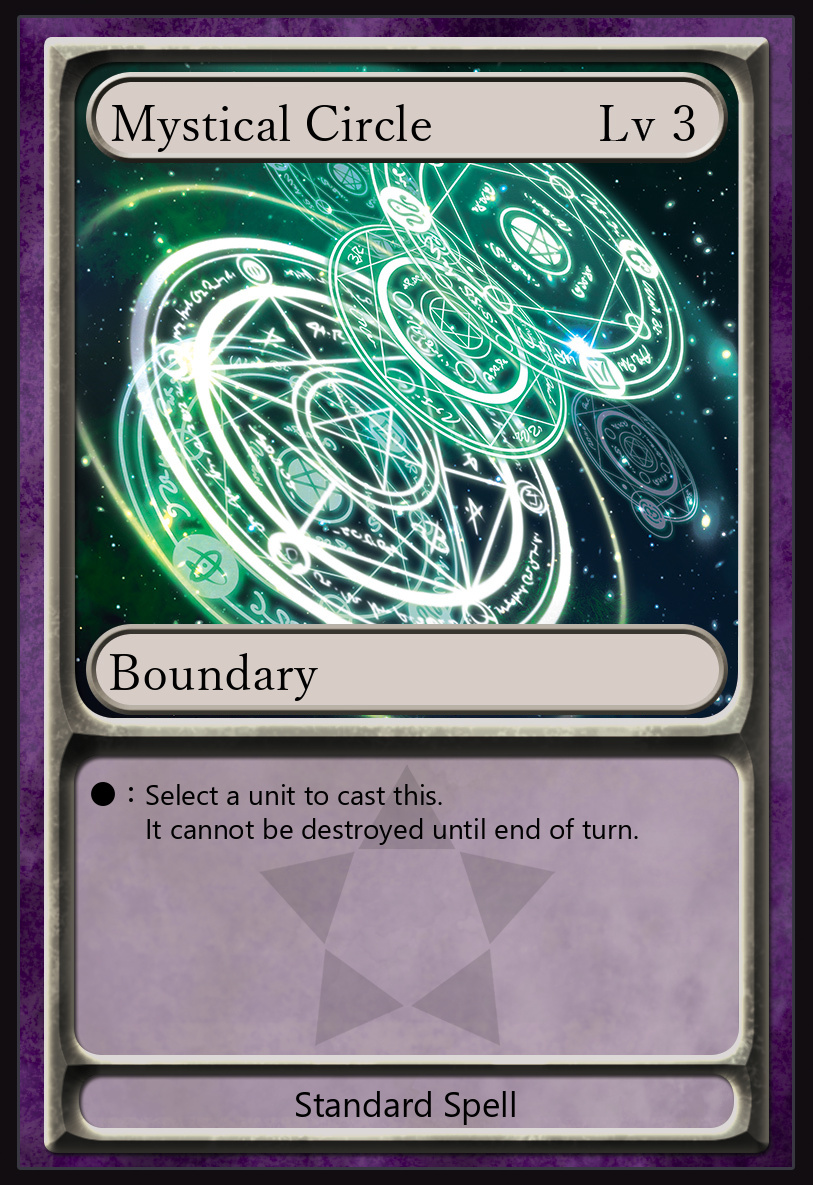 ', for example) the block is interrupted and no damage will be dealt.
', for example) the block is interrupted and no damage will be dealt.
If at least one unit can be destroyed, the effect continues and damage will be dealt.
・ Victory Conditions being met Mid-Block:
If either player meets a victory condition during the execution of a block, the block will be interrupted and the game will end.
・ Target Availability
If the targets of an action aren't available or there are less targets than necessary, you cannot perform the action.
The only exception to this is drawing cards, which can be done regardless of whether or not you have the required number of cards.
That said, you can still perform actions even if you know that they won't actually happen, as long as the target(s) exist.
Example 1:
If there are no spells or items on the field, you cannot activate the effect of 'Large Eerie Flapper '.
'.
Example 2:
You can cast 'Parry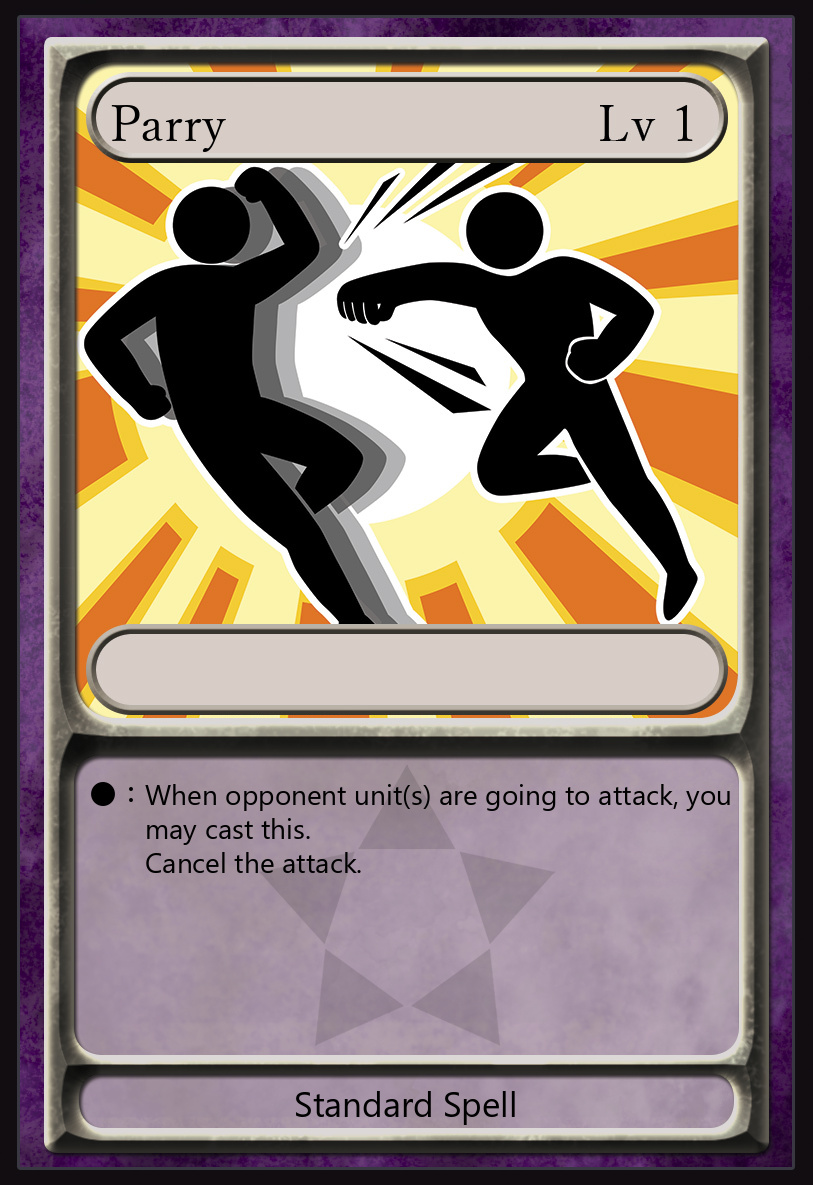 ' against an attack from 'Kudoku Survivor
' against an attack from 'Kudoku Survivor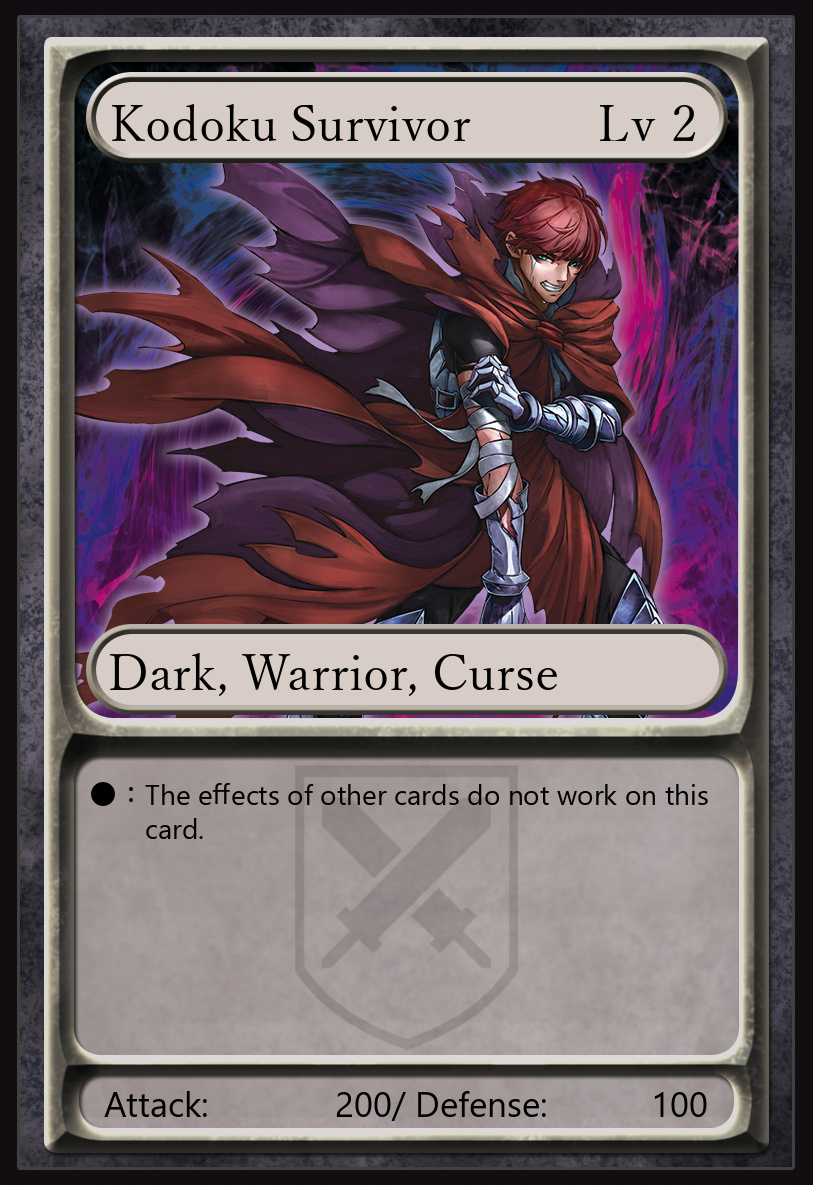 ', even though it won't work.
', even though it won't work.
Example 3:
If a player has no cards in their deck, 'Forest Fire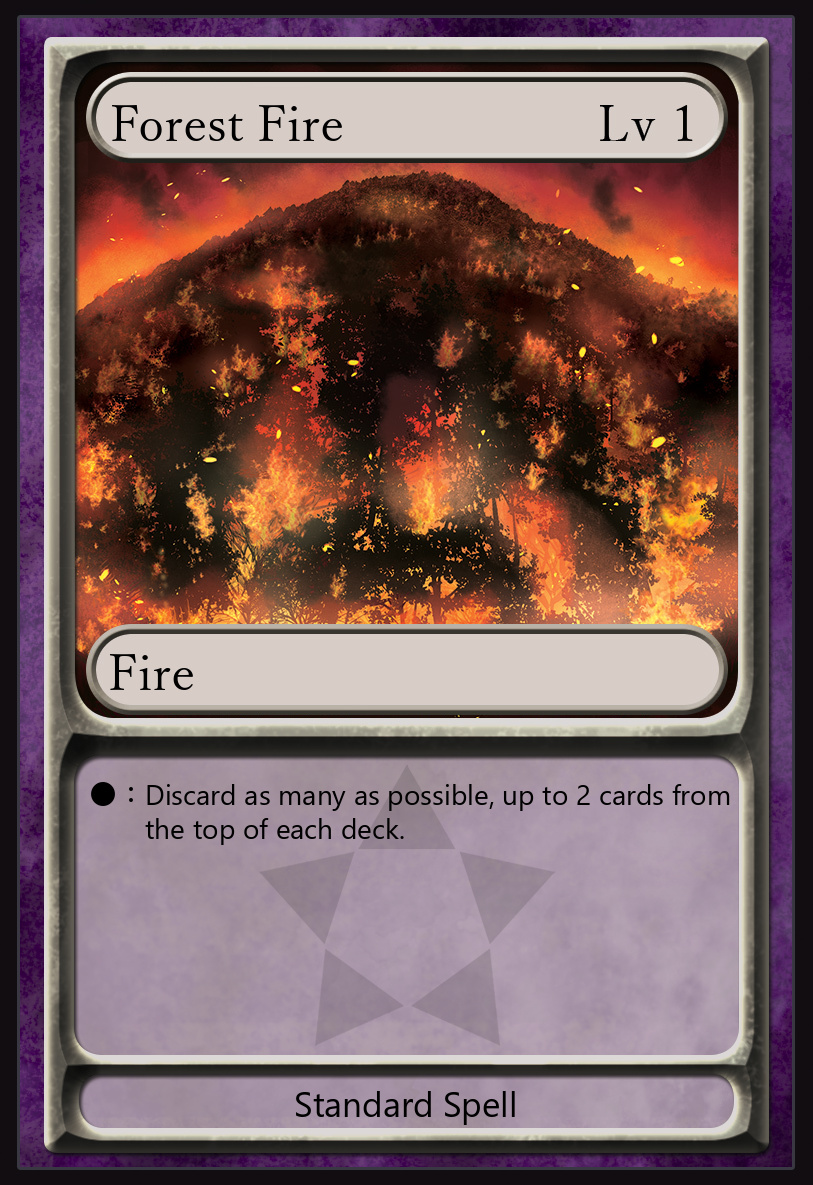 ' can't be cast and its effect can't be resolved.
' can't be cast and its effect can't be resolved.
・ Unactivated Trigger Abilities
If a card moves to another zone after the condition for its trigger ability is met but before the ability gets activated to create a block, it cannot be activated anymore.
If it was activated and the block already exists, it will be executed even if the card moves.
Example:
If 'Haniwa Soldier ' is destroyed by 'Explosion
' is destroyed by 'Explosion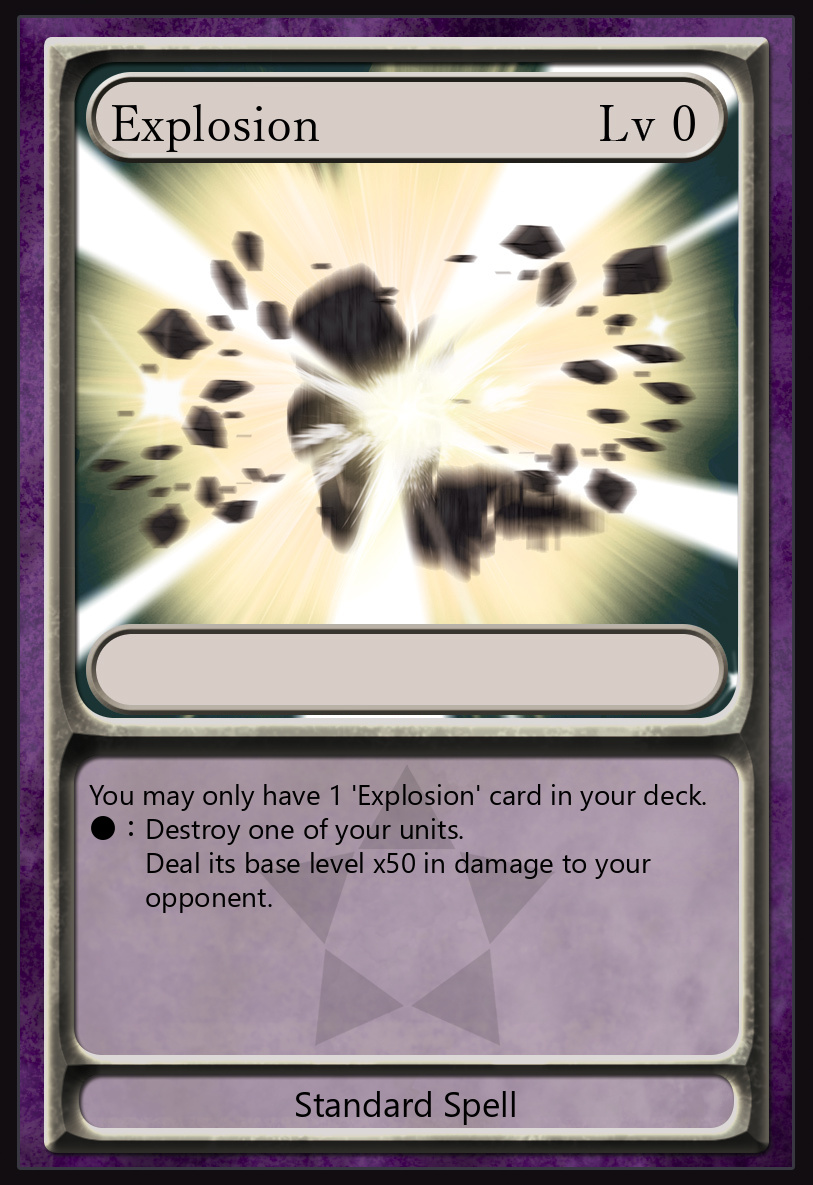 ' in block 2 of a stack and returns to the deck by the effect of 'Transmigration of Cards
' in block 2 of a stack and returns to the deck by the effect of 'Transmigration of Cards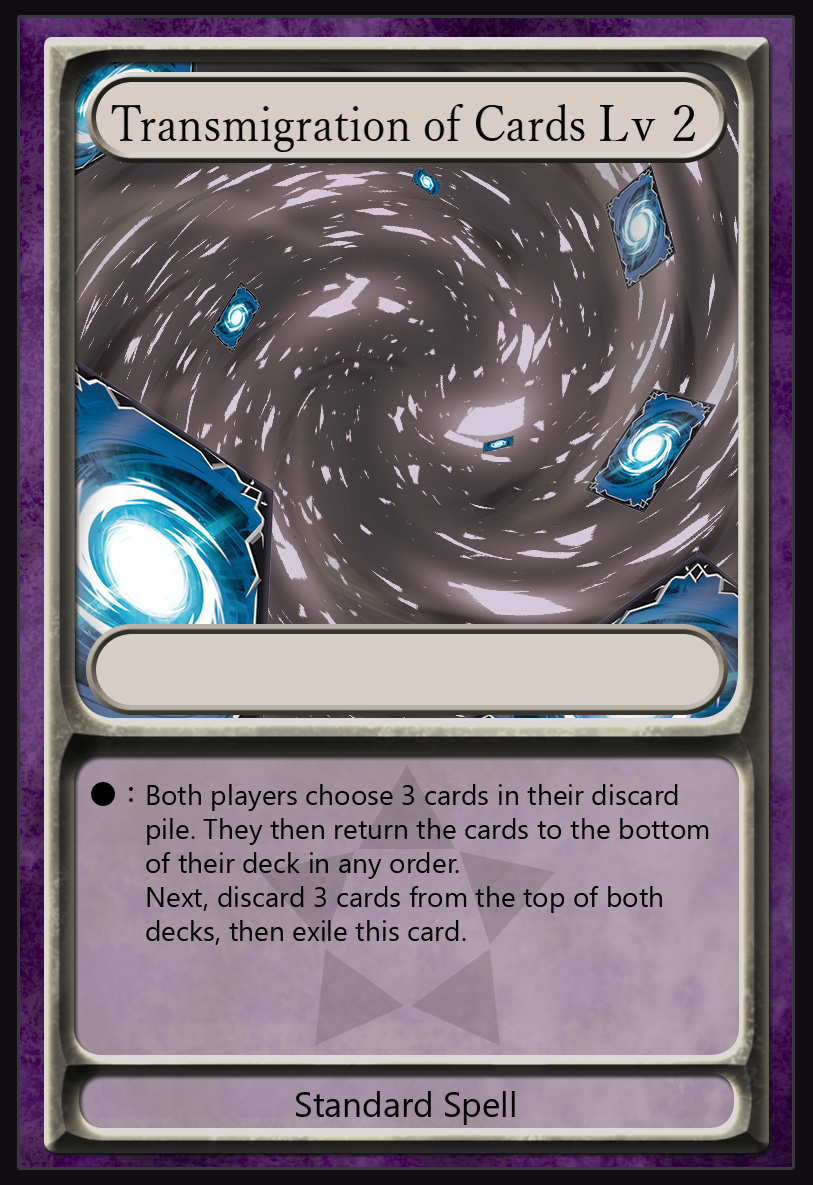 ' in block 1, Haniwa's effect cannot be activated anymore.
' in block 1, Haniwa's effect cannot be activated anymore.
・ Processes at the End of a Turn
The turn ends when both players forfeit their right to create block 1 on a stack 1 of the end phase.
Effects that applied 'during this turn' or 'until end of turn' will cease to apply in the order they were applied.
In the case of static abilities, the time that the card entered the field is counted as the time it was applied.
If this causes the conditions for trigger abilities to be met (by destroying cards, for example), new stacks will be created and processed after all these are done.
If both players then forfeit their right to create a block 1 of stack 1, the end phase will end again and the steps above are repeated.
Things that already happened do not happen again due to this.
・ Minimum Life Restriction
There is no upper limit to your life but the lower limit is 0.
If your life would go below 0 due to damage from a fight or card effect, it will be exactly 0.
When paying life as a cost however, you can't pay more than you have, though you can pay the exact amount you have, bringing it to 0.
There are also no fractional values. In cases where this would happen, you always round up.
・ Minimum Card Stats
There is no upper limit to the level, Attack and Defense of a card but the lower limit is 0.
If it would go below 0 due to card effects, it will end up as 0.
This can cause effects to not change these values at all when they usually would. In those cases the effect is treated as if it completed without issues.
However, if these changes are the cost for an action and there isn't enough level, Attack or Defense to pay, you are unable to pay and can't do the action.
・ The order in which multiple effects are applied
Multiple effects are applied in the order that they come into play in.
Even if one of the effects ends, the rest of them still stay in that order.
For static abilities that do not specify a timing, the moment that an affected card meets its conditions is treated as the time that they came into play.
Example 1:
A Wind-type unit with 200 Attack is enchanted with 'Tailwind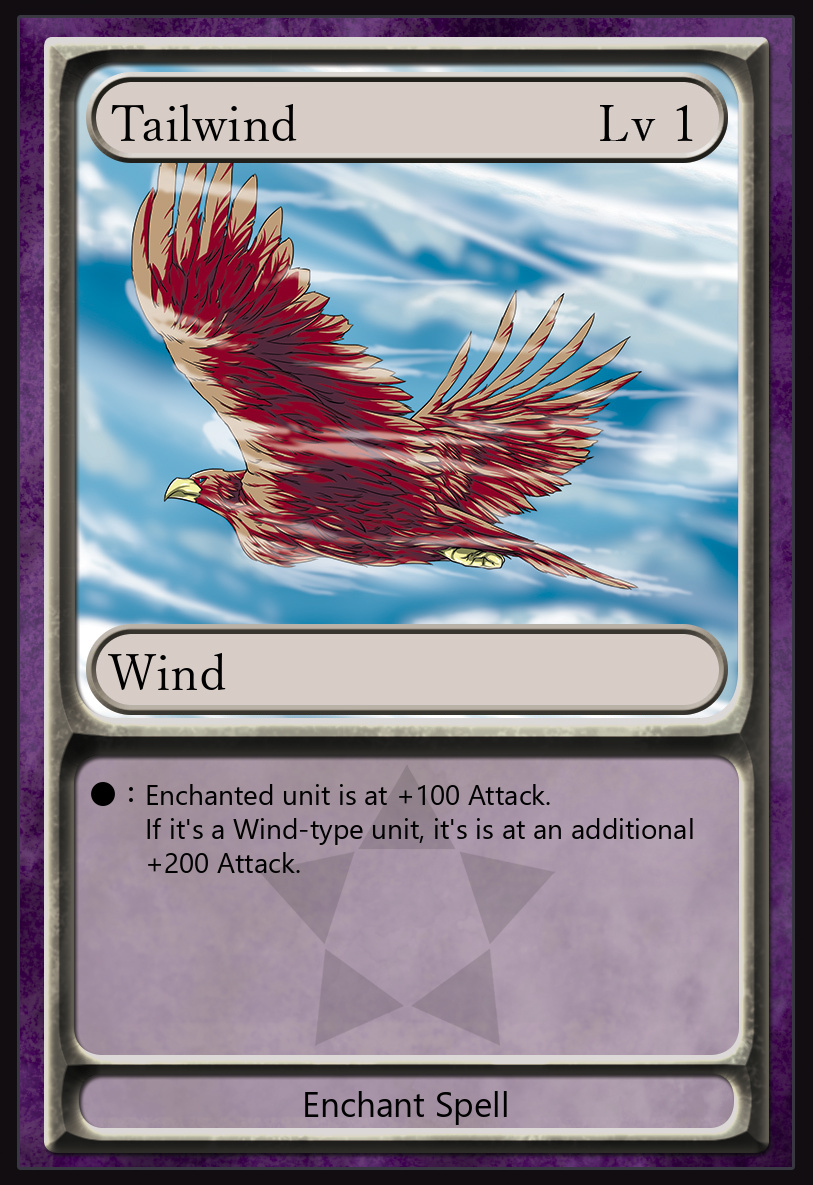 ' after having the effect of 'Damping Barrier
' after having the effect of 'Damping Barrier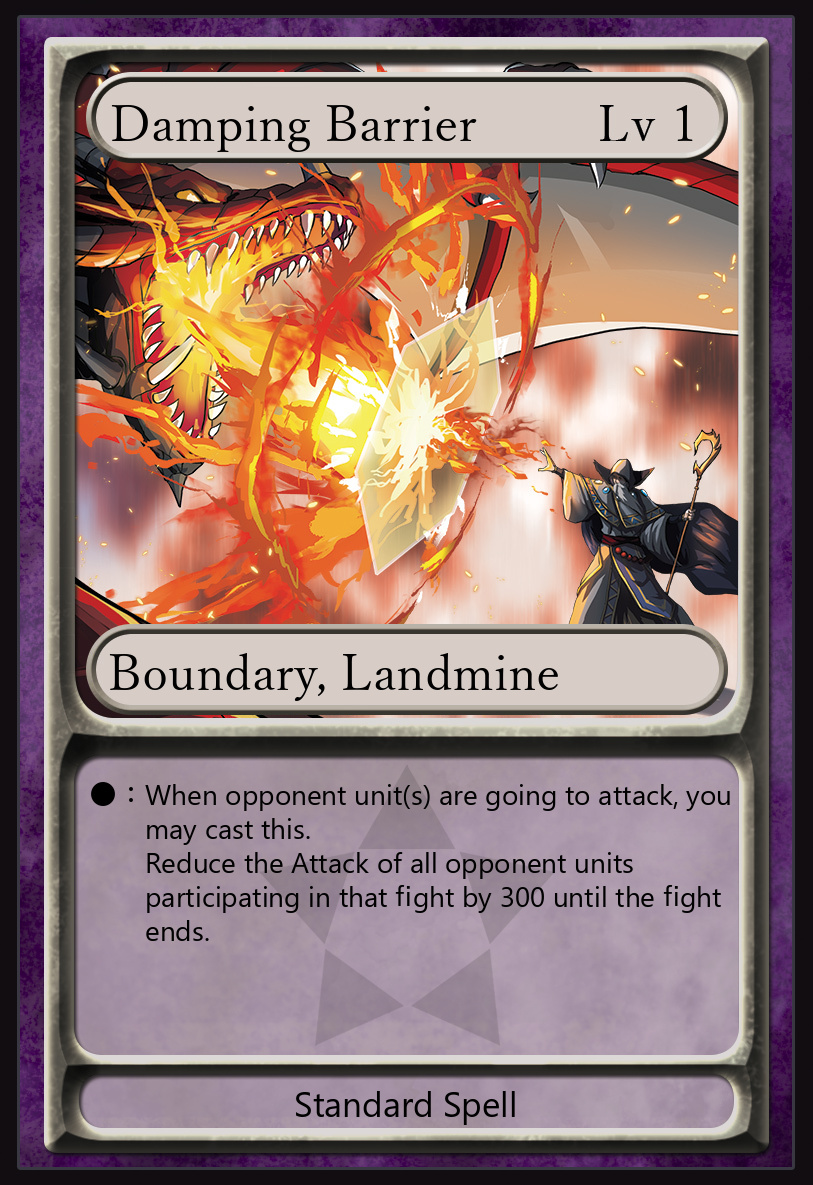 ' applied to it.
' applied to it.
First, Damping Barrier reduces its Attack by 300. Then Tailwind increases the Attack from 0 to 300. (Since it cannot go negative.)
After the fight, the effect of Damping Barrier wears off so only the 300 Attack increase from Tailwind remains, leaving the unit's Attack at 500.
Example 2:
A unit with 800 Attack is enchanted with 'Freeze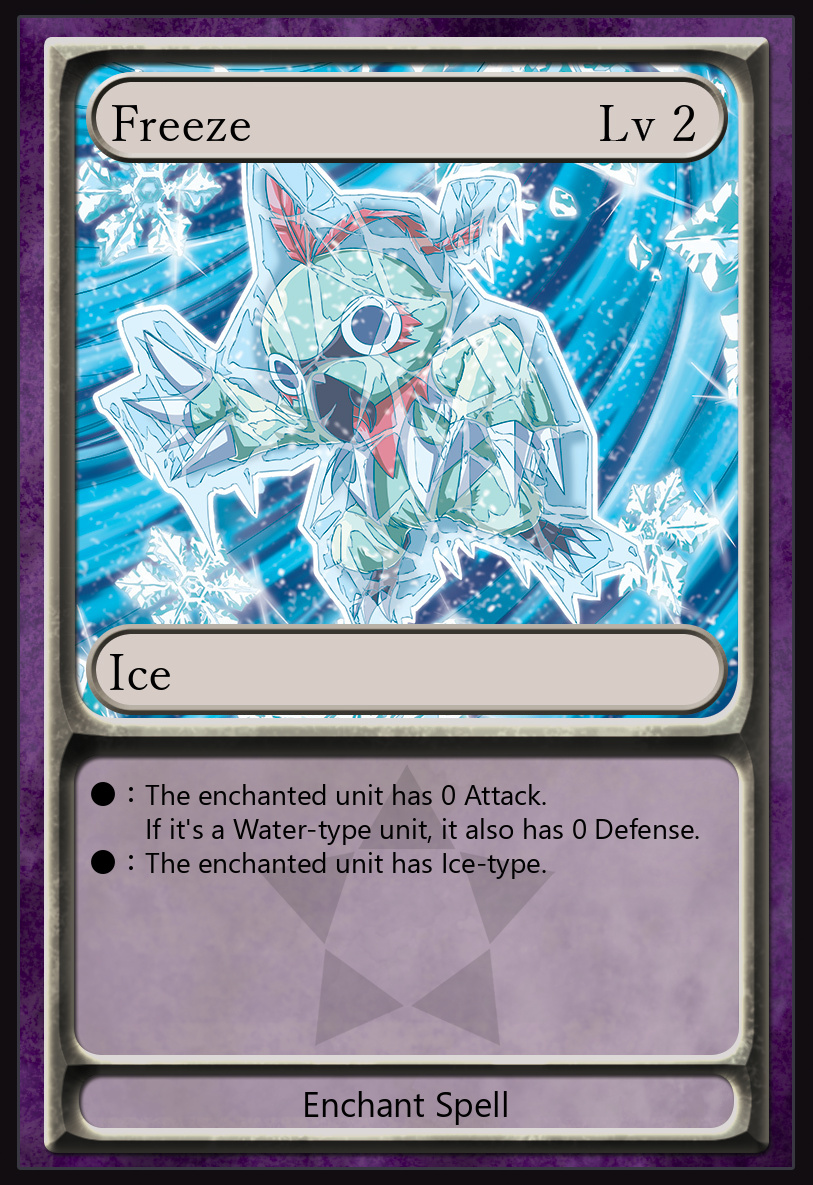 ', then equipped with a 'Common Sword
', then equipped with a 'Common Sword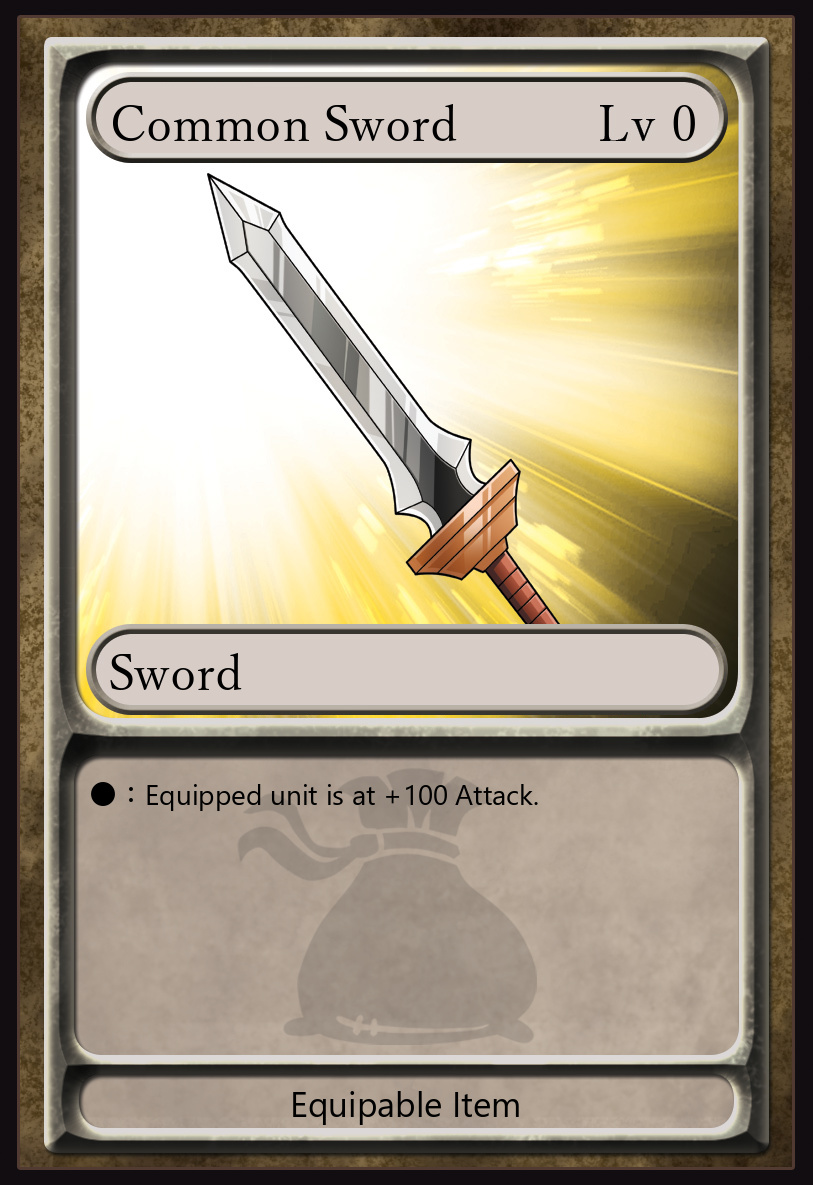 '.
'.
First, its Attack becomes 0 due to the effect of Freeze, then it is increased to 100 by Common Sword.
Had it been enchanted with Freeze after being given Common Sword, its Attack would be 0.
In both cases, if Freeze is destroyed, only Common Sword would apply and the Attack would go up to 900.
・ Timing when multiple static abilities are applied at the same time
First, the static abilities of the affected card are applied.
Next, the static abilities of other cards are applied in the order in which they were put on the field.
If multiple static abilities were put on the field at the same time, the order of application is determined as follows:
1. Static abilties on cards owned by the player on whose side of the field the affected card is on. (If there are multiple, that player gets to decide the order.)
2. Static abilties on the other player's cards. (If there are multiple, that player gets to decide the order.)
・ Priority is given to "can't" effects when multiple effects are applied.
If there are both effects allowing and forbidding a certain action on a single card, the forbidding effect takes priority.
Even if the effect allowing the action is applied after the one that forbids it.
・ Applying effects after a card moves
When a card in the field, discard pile, hand, deck or exile zone moves to a different area, card effects that it was receiving cease to apply.
Example:
If a unit whose Defense was reduced to 0 by 'Weak Point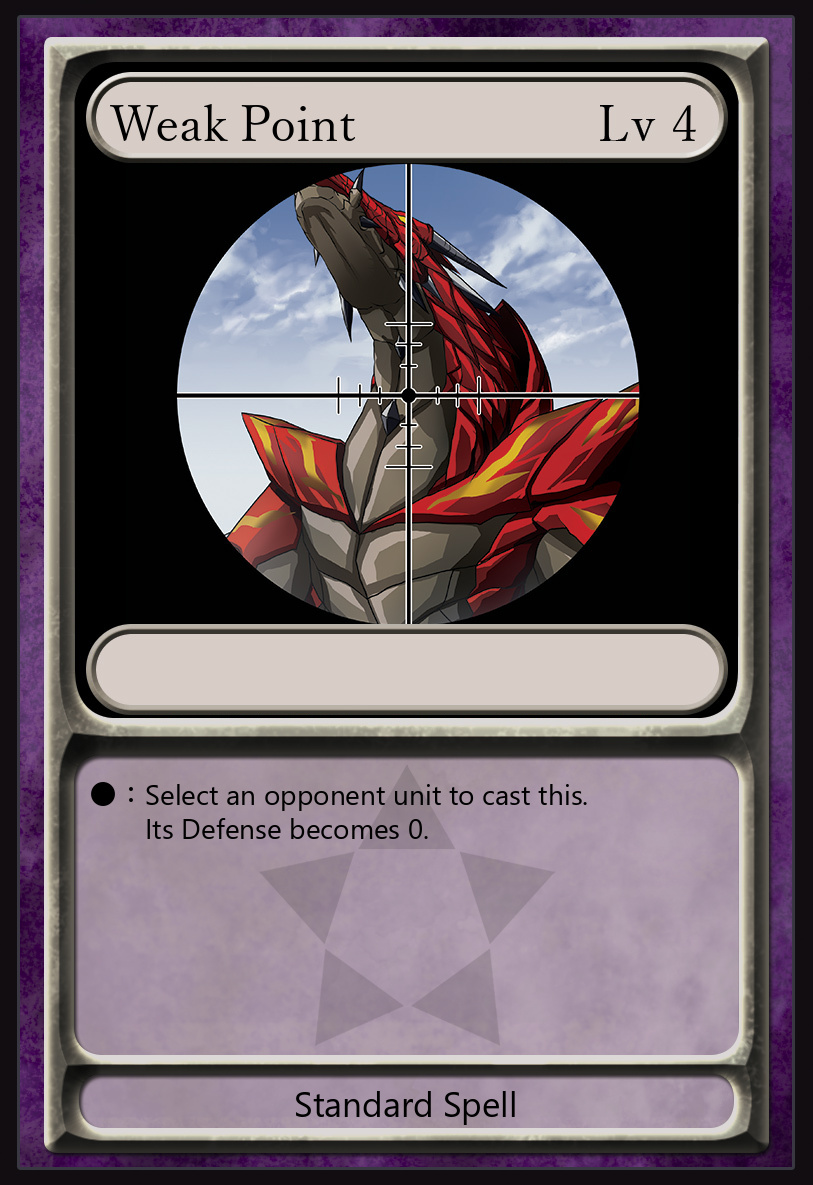 ' is destroyed and moves to the discard pile, its Defense is restored to normal.
' is destroyed and moves to the discard pile, its Defense is restored to normal.
・ When both players need to choose at the same time
If both players need to choose cards at the same time, such as due to 'Transmigration of Cards ', the player whose turn it is gets to choose first.
', the player whose turn it is gets to choose first.
